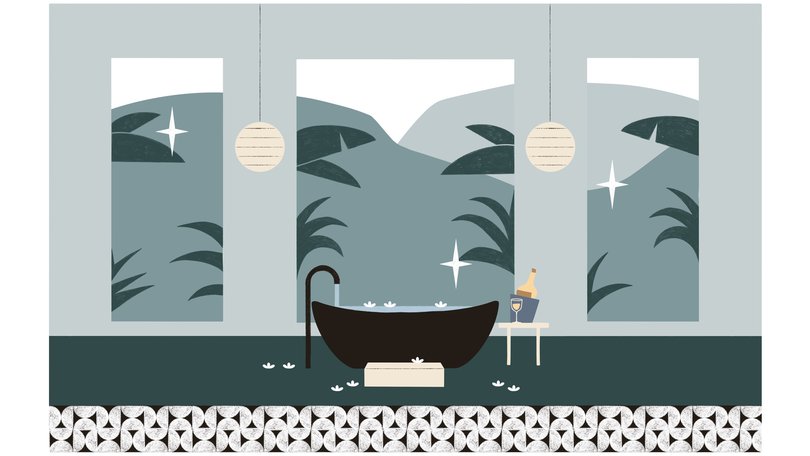The one hotel test that never fails: Why bathrooms reveal everything about your stay

As both a travel writer and a traveller I’ve had the privilege of staying in more than 700 hotels, and I can assure you there is only one foolproof method of telling a good one from a bad one — and you can use it without even looking at the bedrooms.
It’s got nothing to do with ratings on Tripadvisor, which no longer seem to conform to Isaac Newton’s principle that what goes up, must come down: every time a hotel moves down the ranking due to a genuine customer complaint an army of, er, “people” who have often never contributed before rushes in to offer generic five-star reviews.
My method is similarly unconnected with comments left by former guests on the hotel’s own website: these, too, can be as reliable as a taxi driver in Istanbul, as the saying goes. Hotel staff in Vanuatu, for example, begged me to leave a positive review that mentioned them by name, explaining that if I gave them less than nine out of 10, the hotel considered it a fail.
The process is not even related to the warmth of the staff on the reception desk, as 90 per cent of “hospitality” workers in Paris, for instance, will treat every guest as a dangerous criminal — but Paris is home to some of the finest hotels in the world.
ROAM. Landing in your inbox weekly.
A digital-first travel magazine. Premium itineraries and adventures, practical information and exclusive offers for the discerning traveller.
By continuing you agree to our Terms and Privacy Policy.Nor is there any link between the quality of a hotel and its name. The Grand Hotel in Rockdale, Sydney, for example, is only grand in comparison with other hotels in Rockdale. Or it would be if there were any, which there aren’t.
Even geographical names came be deceiving. First-time travellers to Adelaide who pull into the Hilton Hotel on their way from the airport to the city might well be confounded to find a lively local pub with an $18 schnitty night in the inner-western Adelaide suburb of Hilton.
The lobby does not offer any clues either. According to a statistic I have just invented, 90 per cent of hotel lobbies are far better appointed than the bedrooms (this figure rises to 110 per cent in South-East Asia), while only 0.05 per cent of hotel rooms are fancier than their host lobbies.
Of course, you can just turn up at a hotel and ask to look at a room, although this seems to be comparatively rare. When I did so at a guesthouse in Fiji, the owner asked me if I was working for Lonely Planet (which I was).
But if you do get to see a room, there’s no need to jump on the bed — which is a good thing, since most hotels frown on that — you just need to open the bathroom door.
This is because the single infallible predictor of the quality of a hotel is the standard of its bathrooms.
There is no such thing as a bad hotel with good bathrooms, and a “good” hotel with bad bathrooms isn’t a good hotel anyway.
If you get my drift.
I’m not sure if this revelation came to me when a sink collapsed under my weight in a guesthouse in Thailand; or when I flooded my umpteenth London hotel bathroom because the shower door didn’t close properly; or more recently in Italy when I struggled yet again to twist and turn and push and pull a valve on a shower pipe in a doomed attempt to stimulate a vigorous flow of hot (but not scalding) water.
My shower rule of thumb is that if the valve knob has an arm that can be both rotated in either direction and drawn outwards, I will never be able to control both the temperature and the water pressure — and I might as well take a bath in the hotel swimming pool.
A bidet in a bathroom is usually a good sign, whether you like to use one or not. A plug that fits in the plughole — and doesn’t bob back up of its own accord — is also a plus. Apart from anything else, it means you can wash your socks.
In my experience, hotel toilets rarely malfunction as there is not very much that can go wrong with them. Japan is an exception (as is so often the case) since there are aircraft dashboards with fewer controls than a Japanese smart toilet. While some of them may seem a bit niche, there’s a strong argument to be made for a heated seat, particularly in the Japanese ski fields.
Some long-term Western travellers in Asia swear that they come to prefer squat toilets — but their opinions can be dismissed because they’re obviously lying.
Although generally speaking the more bits in the bathroom the better, one utility that you definitely do not need is coloured lighting.
Recently, at a high-tech, hipster-friendly CitizenM Hotel in Rome, I accidentally used my room’s iPad to turn the tone of the bathroom light from neutral to crimson. This made everything look red.
So when I used the bathroom in the morning, I panicked that I was dying. Nonetheless, CitizenM’s establishments are clever and well planned and the bathroom in Rome was large enough to garage a Smart car.
But the one sure sign of a great bathroom is the presence of an actual full-sized bath. In a hotel with a bath in the bathroom, you are certain to enjoy a warm, relaxing, pampered stay.
And even if you don’t, you can always take a bath.
